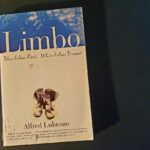Everything seemed solid until recently as if the certainty of tomorrow was an obvious guarantee, a concrete dream. It is curious how everyday life carries this optical illusion, this feeling that everything around us works very well all the time. When some problem sprouts from the ground, it is always seen as something external, punctual, almost as if a strange enemy colonized our untouched harmony. Following a somewhat phenomenological path, this extreme confidence that there is a firm ground beneath our feet, this intuitive faith that everything remains in place, has been given the name of natural attitude, that is, the pre-reflexive certainty that there is a solid world out there just waiting for my innocent participation. Despite this naivety, and all the faith involved, yet nothing prevents this same world from invading us, bringing with it some moments of disruption, scattered frustrations or anguish impossible to name. When this happens, even for a brief moment, it is possible to smell a little of the unstable aroma that flows through the gaps of what they call SOCIETY. Although it has a certain pragmatic role, this noun does not help us at all, mainly because it offers a frozen and linear portrait of things, as if SOCIETY were some living organism floating over our heads. But, on the other hand, what we perceive well, at least when we look at it calmly, is the existence of a vacuum crossing every inch of our daily life, a gap that persists in every word said, in every gesture made.
It is almost ironic that in such a noisy world, so full of opinions, beliefs, and speeches, everyone has bowed down to a single word: CORONAVIRUS. For a brief moment, even though each one follows a different path, we were all taken by the same silence, by a single indefinite, confusing, and frustrating sensation. Even if for a few hours, or even seconds, we experienced a bit of a universal ethics, an ethics that connects not forms of language, but body modalities, almost like a kind of monist version of Spinosa’s vitalism. Nevertheless, this instant of silence did not last long, being soon replaced by tons of interpretations, what theorists of the linguistic turn could easily call verbal juggling.
In an attempt to fill the hole left by the virus, several approaches colonized language in search of a little shade and freshwater, a comfortable and familiar space: 1) Religion claiming that everything is a punishment or divine test. 2) Social sciences believing that it is a sign of a crisis in capitalism or an indication of the failure of our political institutions. 3) The philosophy following existential approaches, tempered with a few phenomenological drops. And last but not least, 4) common sense with its conspiratorial theories, loaded with paranoid traits. Despite the different interpretations, and even the creativity involved in each of them, something remains: a certain transcendentalist matrix in the background (whether human or divine). In other words, there is always the desire to name and, above all, to convert the feeling of scattered anguish into something known and condensed, almost like Captain Ahab in Moby-Dick, by transforming the whale into a point of convergence of its own frustrations. Everyone wants the excess of the pandemic to enter a linear chain of signifiers, turning chance into necessity, chaos into order. The virus, therefore, becomes just another extension of a predictable background of ideas, being nothing more than a pretext. In social sciences, the pandemic ends up becoming an object of study like any other, incorporated in a familiar flux of expected themes: gender inequality, class, race, besides political and economic debates. This movement that transforms the unprecedented into something known, that transforms the shock into word, does not occur loosely, much less arbitrarily, but only happens because of the most important transcendental created by the Human: The Human. The tragedy, in passing through this transcendental structure, becomes a simple management problem, a type of failure that involves the behavior of certain men and women. The very idea of agency is also restricted to humans and what they can or cannot do. This predictable field makes the pandemic not only something capable of being named but also solved. Being within the transcendentalist structure, mainly defined by the boundaries of a certain humanism, make the variables present themselves clearly and as something that can be controlled, just as enemies that can be easily described. Instead of a complex network of relationships, we have well-defined causes (and culprits). Instead of a genealogy, we have a “causelogy”. Instead of a Latourian diplomacy, in a flow of multiple exchanges, uncertainties and possibilities, we come out in a nostalgic search for some kind of humanism. In other words, we believe in the idea that the tragedy of the pandemic is a “social” problem and, therefore, easily solved if the right person, at the right time, and in the right way, appears on the horizon. The tragedy, therefore, is seen as a human management problem, nothing more than a decisional, or even ethical, failure. It is no wonder that populism grows more and more in times of crisis, especially now. The belief that some human being is capable of relieving the burden of suffering seems a constant nowadays. If people suffer, die or fall ill, someone probably did something wrong, someone did not use reason as they should have, in an epistemological approach, or, what is even more common, maybe it was not ethical enough. No matter the argument raised, the premise is always the same, always the same humanism, making the human not only that creature capable of producing everything wonderful, but also everything grotesque. It is a kind of backward humanism, a half-pessimistic version, but still a humanism, that is, the belief that we are so powerful that fate is always in our hands, no matter if the consequences are good or bad.
The Lacanian Virus in Social Sciences
In Lacanian psychoanalysis the Thing is an interesting concept, being an object that lets slip traces of the famous REAL, that is, it brings with it traces of something that overflows and silences (Kay, 2003), no matter if it is a dog, a table, a notebook, or even a virus. The Thing lets flow the acid smell of the Beckettian unnamable, of what is on the very frontier of meaning. In other words, it threatens any transcendental structure, any type of organ without body, as Slavoj Žižek (2016) would say, by reversing the Deleuzian arrangement of the body without organ. “The Thing [is] the pure substance of enjoyment resisting symbolization” (Žižek, 1992, p. 8), being any kind of object, but with a “surplus”, a kind of liquid that overflows from its apparent and solid identity. This Real liquid has no name, color, smell, or even outline, being only that which is on the edge, almost as if it were the rest that the Kantian model let slip, its thing itself, what Jane Bennet (2010) called absolute. Unlike other areas, in psychoanalysis, or even in Alternative Social Theory (A.S.T), the aim is not to replace one interpretation with another, much less one transcendental with another, as is to be expected from approaches that claim to be critical, but rather to go beyond, imploding one’s own interpretative structure, often mocking one’s own articulate language (the humorous style in Latour essays, or the sarcasm of Nietzschean aphorisms, are not an example of a type of language that mocks itself, decentering its own internal consistency?) The commitment of psychoanalysis, or even of vitalism in A.S.T, with its critique of the metaphysics of presence or of ontotheology itself, is something simpler than it seems, nothing from another planet: it is necessary to make a “hole in language” (Badiou, 2003), at least in that common and transcendentalist one, being necessary to go beyond itself, especially when it fails, when it breaks, when it lets the smell of the Thing escapes from the background. This breaking of a transcendental language may seem a bit frightening, or at least strange, mainly because transcendentalism plays an important pragmatic role, being not only a condition of possibility of knowledge, in an epistemological sense, but also a condition of existence of the practice itself. According to this, “why criticize something that works so well?”, you can ask me. And that is precisely the problem of transcendentalism, especially in its humanistic sense. It works so well, but so well, that nothing escapes, nothing surprises, nothing overflows. In Lacanian terms, this means that the other loses his autonomy and becomes just an extension of any expectation, be it from the symbolic order or even on an imaginary level at the borders of the Ego itself. In vitalistic terms, these transcendental structures colonize the possibilities of meaning, not only defining their outlines but depriving other entities or objects (Harman, 2011). By having this structure broken, however inconvenient it may seem, a multiplicity of new agents appears on the horizon, as well as thousands of new alternatives of meaning and interactions.
When transcendentalism cracks, when it loses its consistency, what is left is a reality that has its own autonomy, no longer submitting itself to a symbolic or imaginary structure of the human: the other simply invades us, overflow us. Contrary to other classical approaches in the human sciences, in A.S.T (Alternative Social Theory) the world ceases to be only an extension of a certain expectation and begins to assert itself on its own. Wouldn’t Coronavirus be what resists any imaginary or symbolic effort, being a kind of excess that frustrates us, at the same time that it launches us into an unprecedented field of possibilities? Of course, if you are a classical social theorist, Coronavirus has nothing to teach, since it becomes only an object framed in a predictable matrix of meaning, especially that which reduces the virus to human decision processes and nothing beyond. On the other hand, if you follow an alternative path, and not a little transcendentalist, the virus does not present itself as a fixed identity incorporated in any transcendental, much less human, being much more an autonomous element with its own rhythm, which in A.S.T gets several names: hybrid (Latour, 1994), hairy thing (Latour, 1979), plasma (Latour, 1994), surplus of life (Massumi, 2014), the logic of immanence (Bryant, 2011), body without organs (Deleuze, 1987), Thing (Kay, 2003), The Stain (Žižek, 1992), mesh (Ingold, 2012), fluids (Mol and Law, 1994), the dancer object (Haraway, 2008), real object (Harman, 2011), vibrating matter (Bennet, 2010).
Perhaps this silence, this vacuum left by the virus, will end up being more significant than the thousands of attempts to fill it, however well-elaborated they may seem, at least at first sight. We are not talking about a simple problem, but a pandemic that has never seen before… a pandemic that not only interrupted the plans of the “dirty capitalist” but also of the “dirty capitalist critic”… a pandemic that closed markets, as well as churches and universities… a pandemic that affects the poor, no doubt about it, although nobody is safe.
If even a pandemic of this order could not compromise the walls of our own language, and the symbolic fabric behind them, it is ironic to talk about debates or any form of reflection, as if it were that simple. If not even the extreme of the possible, on the borders of chaos itself, does not affect us on a deeper level, only serving as an element that reinforces what has always existed, and what we have always thought about, the very idea of reflection becomes a distant dream, often a joke. In psychoanalysis, this extreme element that supposedly alters the course of everything, but ends up only reinforcing its initial contours, is called the quilting point (Žižek, 2006). In other words, instead of the pandemic being an extreme case that puts our language against the wall, forcing us to rethink the very inner and fragile core of its chains of signifiers, what we have is the complete opposite. The pandemic becomes another object, a simple pretext within a series of simplified interpretations, without any novelty. Of course, this transcendentalist card has its charm and pragmatic function, since it keeps the pandemic within convenient limits, within a predictable space involving human decisions.
I am sorry to disappoint the transcendentalist expectation of classic Social Theory, but the Coronavirus is something out of the ordinary, an event, in the sense given by Badiou, or a radical encounter, as Spinosa imagined. Although it is predictable to fit the strange in the borders of the familiar, of what we already know, many times the silence can be worth more. Deep down, where the underground of subjectivity finds its starting point, everyone knows that something in this whole story escapes, overflows, something that takes us by surprise and leaves us without voice, without ground. The Alternative Social Theory (A.S.T) manages to better interpret the Covid-19 pandemic precisely because it refuses the interpretation, at least that transcendentalist one, that is, refusing the desperate desire for a common, predictable and comfortable exit. It forces us to face the unspeakable field of the unpredictable, long before resorting to ready and available formulas.
Perhaps it is the right time to rethink many things, but not just practices or certain issues, but perhaps to rethink the very structure of our language and the pretentious way in which we address the world and ourselves. Although there are several attempts of interpretation in the universe of social theory, they all slide on a thin ice ground, trying to escape the painful and rough horizon of a Real that not only compromises the convenience of our language but mocks all its pretension. Alternative Social Theory manages to interpret Coronavirus because it does not interpret it, but it faces the silence left by the weight of circumstances, as well as its autonomy, without that paranoid or transcendentalist desire. A.S.T reminds us of the importance of that silence, that initial shock, that feeling that something is bigger than I thought, although soon after other approaches appear and fill the gap. Instead of working with language, and its epistemological limits, it is concerned with an ontology beyond the usual humanism, one that opens itself to new possibilities of meaning, including new agents in play.
References:
BENNET, Jane. Vibrant Matter: A Political Ecology of Things. Durham: Duke University 2010.
BADIOU, Alain. On Beckett. California: Stanford University Press, 2003, p. XXIII.
BRYANT, Levi R. The Democracy of Objects. Michigan: Open Humanities Press, 2011.
DELEUZE, Gilles. A thousand Plateaus: capitalism and schizophrenia. University of Minnesota Press: London, 1987.
HARMAN, Graham. The Quadruple Object. Winchester: Zero Books, 2011. HARAWAY, Donna. When Species Meet. Minneapolis: Minnesota Press, 2008.
INGOLD, Tim. Bringing things back to life: creative tangles in a world of materials.
Anthropological Horizons, Porto Alegre, v. 18, n. 37, p. 25-44, 2012.
KAY, Sarah. Žižek: A Critical Introduction. Cambridge: Polity Press, 2003.
LATOUR, Bruno. We were never modern: symmetrical anthropology essay. Rio de Janeiro: Editora 34, 1994.
. The laboratory life: the production of scientific facts. Rio de Janeiro: Editora Relumé Dumará, 1979.
MASSUMI, Brian. What the animals can teach us about politics. US: Duke University Press, 2014.
. Enjoy your Symptom. UK: Routledge, 1992.
. To read Lacan. Rio de Janeiro: Zahar, 2006.
_.Organs Without Bodies: Deleuze and consequences. UK: Routledge, 2016.










